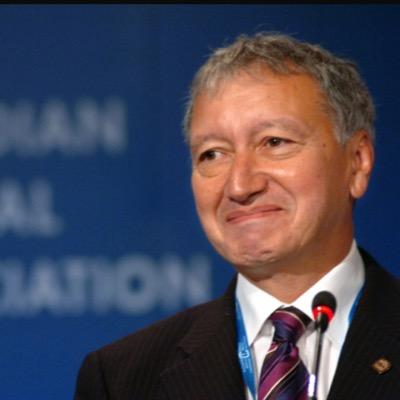
Dr. Brian Day
@DrBrianDay 
- Past President Canadian Medical Association
- Past President Arthroscopy Association of North America
- Honourary Associate Professor University of British Columbia
- 2014 Doctors of BC Don Rix Leadership Award


Dr. Brian Day
President
Canadian Medical Association
Halifax
Good morning. My pleasure to be here today and to have met and talked with many of you last night.
I trust hockey went well and there are no MCLs or ACLs that I need to look at?
As many of you know, the CMA is pressing politicians to recognize the need to build a patient-focused health care system.
The idea is that patients should not have to languish on wait lists, and that we must address the fact that it costs more to have patients wait for care than it does to treat them.
In January the CMA released new research showing that patients waiting for care in Canada cost our economy $14.8 billion in 2007 alone.
More recently, a study has pegged the estimated cost of mental health in Canada to be a staggering $51 billion. That's a lot of money.
Canadian taxpayers are spending vast amounts of money in order to limit access and keep people waiting. We are paying to prevent patients getting better. The prevention of patients getting better is not what doctors mean when we talk about preventative medicine.
Building a patient-focused system requires a shift in thinking, a shift that involves creating incentives to treat patients instead of dis-incentives that make them wait.
Now, I realize that the current wait times agenda does not fully address the basic needs of Canadians in rural communities who often face difficulty accessing primary health care.
Not to mention the difficulty keeping health care providers in their communities, or the hurdles that must be overcome to accessing diagnostic services and other more advanced treatments.
However, building a system that works for patients, instead of one that forces patients to work the system must a central tenet of our renewed system.
I am happy to go into more detail on the notion of increasing incentives within the system to put patients first, but I would like to turn my attention to an issue on all of our minds: Canada's physician shortage.
Just as it is for the SRPC, addressing Canada's doctor shortage is of critical concern to the CMA.
Right now, the CMA's "More Doctors, More Care" campaign is pressing our politicians to take action. We want a patient-focused system that is accountable, effective, efficient and sustainable.
The campaign stresses that such a system can't exist without enough doctors. We are 26,000 doctors short of the average in developed countries, and we now lag behind at 24th in the world in the number of doctors per population. In 1970, we were 4th.
Of course, the "rural reality" is even more daunting.
As SRPC President Dr. Jong has pointed out:
Right now there are fifteen hundred young Canadians going to medical school in foreign countries. These are "A" students, Canadians, who have been forced to leave the country for their medical training.
Consider if even a small fraction of that number came from rural backgrounds, and were interested in returning to their home communities.
I get emails and letters saying just that. It is ridiculous that we export our most precious resource - our young - when they are so desperately needed here at home.
In the short term, we need to encourage them to return (most don't), but in the long term, we need to expand capacity and create new medical schools.
Thousands of Canadians have supported the "More Doctors" campaign by sending postcards to the Prime Minister and urging immediate action. These postcards are available at moredoctors.ca, so please consider joining our effort.
We are pressing governments to increase our capacity to train health professionals, to support research and to collect and evaluate data on Canada's health workforce.
I salute the leadership and members of the SRPC for pressing this issue forward and for highlighting the need for action as well.
Yesterday, to mark the opening of this meeting, Dr. Jong and I sent out a press release calling for a national strategy to address the issue of physician shortages.
Our message, I think, is clear: Canada needs a national health workforce strategy. This strategy would help eliminate the unhelpful practice of provinces, regions and communities poaching physicians from each other.
It would recognize that the sustainability of communities - especially rural communities - hinges on the ability for residents to access health care.
Right now the biggest barrier to Canada becoming self-sufficient in terms of physician resources is the capacity of our medical schools.
Even with recent spikes in enrolment and the new Northern Ontario Medical School we continue to turn away about 3 equally qualified medical students for every one that is accepted into an undergraduate medical program.
We are pressing the federal government to address this by establishing a one-billion-dollar National Health Human Resources Fund over 5 years to expand health professional education and training capacity.
This fund would support the:
There is precedent for the federal government to take such action.
The implementation of Medicare in Canada in the 1960s required a major investment in the capacity to train more health professionals.
The 1966 Health Resources Fund Act played a key role in expanding training capacity across the provinces for a range of health professionals.
Forty years later, Canada faces growing shortages across most health disciplines.
Clearly another giant step up is required in the human and physical infrastructure needed to train health professionals if Canadians are to have timely access to care.
If we are going to have sufficient numbers of health providers to meet the needs of the next few decades, we must expand the human and physician infrastructure capacity of our health professional education and training system.
As Dr. Jong has said clearly: governments are not doing enough to ensure the health care needs of all Canadians are met.
The CMA is committed to continuing to press the government to act on this issue and I would be very interested in discussing with you options for taking our messages forward together.
Thank you.